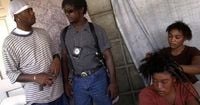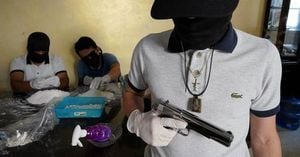On September 16, 2025, the streets of Gonaïves, a coastal city in Haiti’s Artibonite region, erupted with tension and unrest following the fatal shooting of Wilfort Ferdinand, a figure whose name has long resonated in the country’s turbulent political and criminal history. Ferdinand, better known by his alias Kòmandan Ti Wil, was a former rebel leader, a suspected gang boss, and a key player in the 2004 uprising that ousted then-President Jean-Bertrand Aristide. His death at the hands of the Haitian National Police has sent shockwaves through the community, prompting ongoing protests and business closures, and highlighting the persistent volatility that grips parts of Haiti.
According to the Haitian National Police, the incident unfolded during what was described as a routine checkpoint operation in Gonaïves, part of a broader effort to crack down on the Kokorat San Ras gang. This gang, infamous for its extreme violence, has long plagued the Artibonite region, making the area a focal point for law enforcement’s ongoing battle against organized crime. Police spokesman Michel-Ange Louis Jeune told The Associated Press, “Police had no intention of killing anyone.” Yet, the confrontation quickly escalated.
Police accounts, echoed by multiple news outlets including the Caribbean Media Corporation and The Associated Press, detail how Ferdinand approached the checkpoint in a car with heavily tinted windows. Rather than comply, he reportedly backed up and opened fire on the officers. In the ensuing exchange, police returned fire, killing Ferdinand and an unidentified passenger who was traveling with him. The acting director general of the Haitian National Police confirmed that Ferdinand died during this exchange of gunfire as police were executing a warrant in the Canal Bois neighborhood of Gonaïves.
Local media painted a chaotic scene in the aftermath of the shooting. Heavy gunfire was reported in the area shortly after Ferdinand’s death, and graphic images of the incident quickly circulated on social media. These images—gruesome and visceral—sparked immediate protests in Gonaïves. Businesses shuttered their doors as residents took to the streets, expressing anger and frustration. The city, already on edge due to ongoing gang violence and political instability, was plunged into deeper uncertainty.
Ferdinand’s legacy is complex and controversial. As the leader of the Artibonite Resistance Front, he was both feared and respected by different segments of Haitian society. His role in the 2004 uprising placed him at the center of a pivotal moment in the nation’s history—the ousting of Aristide, a former priest whose presidency was marked by both populist reforms and deepening unrest. Ferdinand was closely allied with Guy Philippe, another former rebel leader and a man whose own story is layered with intrigue: Philippe is a former police officer, politician, and convicted money launderer who led the coup d’état against Aristide after being dismissed from the police force in 2000.
The police operation that led to Ferdinand’s death was part of an ongoing campaign against the Kokorat San Ras gang. This gang’s notoriety for brutality is well known, and law enforcement has faced immense challenges in curbing its influence. The checkpoint where the fatal encounter occurred was described by police as a routine measure, but in a region where criminal groups often wield significant power, even routine operations can have unpredictable and deadly outcomes.
“Police had no intention of killing anyone,” Jeune reiterated, a statement that underscores the fraught relationship between law enforcement and the communities they serve. In Haiti, where trust in official institutions is often fragile, such assurances can ring hollow, especially when violence flares and high-profile figures are killed. The swift and violent nature of Ferdinand’s death, coupled with the rapid spread of graphic images online, only fueled the anger and suspicion among locals.
The protests that followed have been intense and sustained. Residents of Gonaïves, already grappling with the daily realities of insecurity and economic hardship, have taken to the streets in force. The killing of Ferdinand appears to have acted as a catalyst, bringing longstanding grievances to the surface. Businesses have remained closed as demonstrations continue, a testament to both the fear and the solidarity felt by many in the community.
Ferdinand’s ties to Guy Philippe also add a layer of political complexity to the story. Philippe’s own checkered past—his leadership in the 2004 coup, his subsequent political career, and his conviction for money laundering—reflects the tangled web of alliances and enmities that define Haiti’s recent history. The Artibonite Resistance Front, under Ferdinand’s leadership, was a significant force during the uprising against Aristide, and its legacy continues to shape the region’s dynamics.
Observers note that the circulation of graphic images from the scene of Ferdinand’s death has played a significant role in shaping public reaction. In a country where social media is increasingly influential, such images can quickly inflame passions and mobilize protest. The visual evidence of violence, combined with longstanding distrust of police motives, has made it difficult for authorities to control the narrative or restore calm.
For many in Gonaïves and beyond, the incident is emblematic of broader issues facing Haiti: the persistent power of armed groups, the challenges of law enforcement, and the deep scars left by years of political upheaval. The death of a figure like Wilfort Ferdinand is not simply a matter of criminal justice—it is a flashpoint in a society struggling to find stability and security.
As the situation in Gonaïves continues to unfold, the government and police face mounting pressure to address both the immediate unrest and the underlying causes of violence in the region. The killing of Ferdinand may have removed a notorious figure from the scene, but it has also reignited debates about justice, accountability, and the future of Haiti’s troubled Artibonite region.
In the coming days, all eyes will remain on Gonaïves, where the echoes of gunfire and the chants of protestors serve as a stark reminder of the challenges that lie ahead for Haiti’s leaders and its people.





